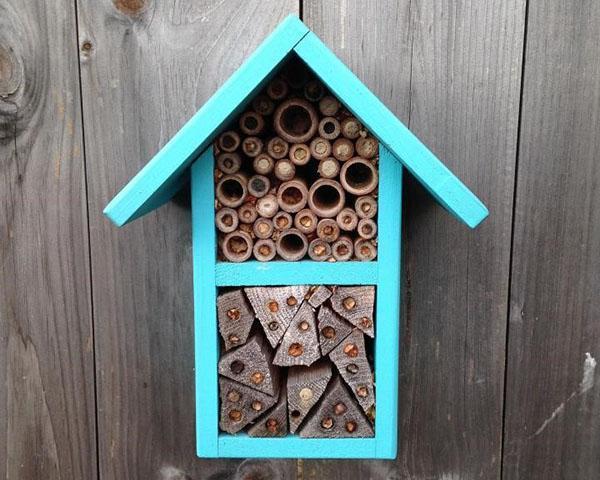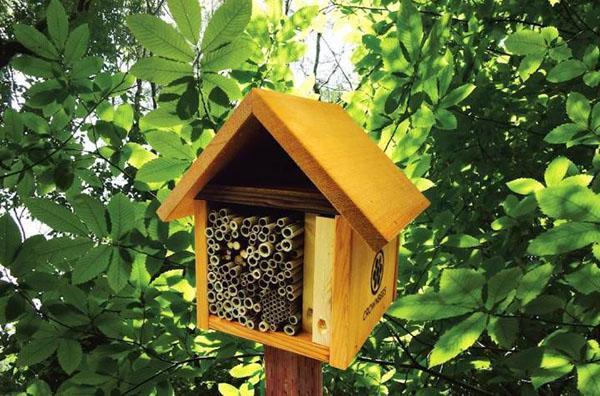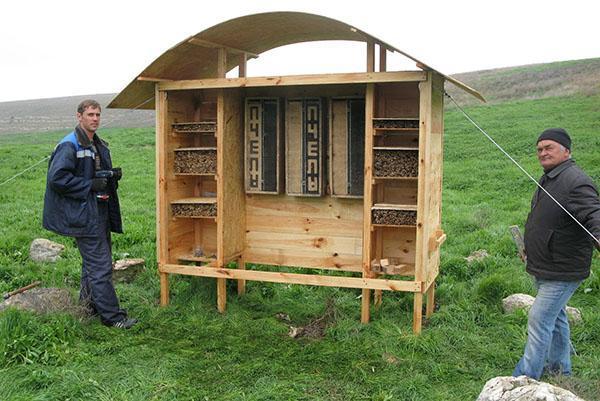Building a house for single bees
 The secret to a large number of lush flowers and a rich harvest is good pollination. To make this process more productive, consider building a bee house in your backyard.
The secret to a large number of lush flowers and a rich harvest is good pollination. To make this process more productive, consider building a bee house in your backyard.
What a bee "hotel" looks like

 Bee houses are made of wood, inside of which there are natural materials suitable for beekeeping: hollow reeds or cardboard tubes. They are ideal habitats for solitary bees that like to nest there and pollinate the surrounding plants.
Bee houses are made of wood, inside of which there are natural materials suitable for beekeeping: hollow reeds or cardboard tubes. They are ideal habitats for solitary bees that like to nest there and pollinate the surrounding plants.
6 tips for a successful bee home
We will share the experience of foreign gardeners and give 6 important recommendations that will allow you to peacefully coexist with buzzing insects.
Avoid oversized
 While the 1.2m wide and 1.8m high design looks great, attracts a lot of attention and increases the growth of local bees inside, this size would be overly ambitious and likely to be a burden to keep. As well as birdhouses that need to be cleaned at the end of each year, insect dwellings need to be updated with fresh nesting materials every year. In general, this does not take a lot of time, but think about how problematic it will be to manage all the “guests” that sit inside.
While the 1.2m wide and 1.8m high design looks great, attracts a lot of attention and increases the growth of local bees inside, this size would be overly ambitious and likely to be a burden to keep. As well as birdhouses that need to be cleaned at the end of each year, insect dwellings need to be updated with fresh nesting materials every year. In general, this does not take a lot of time, but think about how problematic it will be to manage all the “guests” that sit inside.
Be sure to choose a house size that matches the surrounding area. For example, a cluster of flowering trees and shrubs can provide more pollen than a flower lawn. Accordingly, a larger structure is more relevant for the first option.
Protect nesting sites from wind, rain and birds
 Nesting insects need a place to live that is dry and safe. An ideal bee house will have an overhang of about 7 cm to protect the contents from the vagaries of the weather. If birds are trying to attack nesting holes, take a wire mesh and wrap it around the house like a bubble.
Nesting insects need a place to live that is dry and safe. An ideal bee house will have an overhang of about 7 cm to protect the contents from the vagaries of the weather. If birds are trying to attack nesting holes, take a wire mesh and wrap it around the house like a bubble.
Do not place the net directly on the nest exits as this will prevent bees from entering. They need a place to take off and land.
Use the right materials in the right size
 Natural, nearby materials work best. Cardboard tubes and lake reeds for bee nests with the correct dimensions can be easily found online.
Natural, nearby materials work best. Cardboard tubes and lake reeds for bee nests with the correct dimensions can be easily found online.
Avoid bamboo and plastic straws, as they do not provide adequate moisture evaporation, which causes problems in the development of bees. The holes for the nests should be from 4 to 10 mm, and go about 15 cm deep. If the holes are too small, this will negatively affect the sexual function of the next generation of insects.
Location and a few words about wasps
Orient the bee house towards the morning sun as solitary bees need warmth to get the energy to fly. Placing two buildings, each with a slightly different angle, can produce better results.
 Most insects prefer midday shade, but large, shaded areas attract solitary wasps.Usually, they are considered useful predatory insects, garden orderlies that attack pests such as caterpillars, larvae and aphids. However, they can hunt bee pupae by climbing right into the house.
Most insects prefer midday shade, but large, shaded areas attract solitary wasps.Usually, they are considered useful predatory insects, garden orderlies that attack pests such as caterpillars, larvae and aphids. However, they can hunt bee pupae by climbing right into the house.
Bee larvae need protection in winter
 Make sure the insect dwelling is easily accessible so that you can easily remove the filled nesting tubes and store them in a warm, dry place. They must be kept in the same conditions and at the same temperature as outdoors, such as in a garden shed or unheated garage.
Make sure the insect dwelling is easily accessible so that you can easily remove the filled nesting tubes and store them in a warm, dry place. They must be kept in the same conditions and at the same temperature as outdoors, such as in a garden shed or unheated garage.
Some varieties of bees can produce several generations per season, so monitor the filling of the nest tubes.
Collect bee cocoons every spring
After protecting and storing nesting materials during the winter, remove them and collect the cocoons in early spring. If possible, separate them according to their appearance. With proper care, these cocoons will evolve into a new generation of pollinators and future bees.
Now you know a little more about these amazing creatures and what kind of shelter they need to live in your yard. Your efforts to build and maintain their home will pay off handsomely when it's time to harvest.